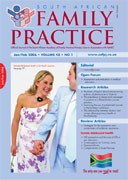Improving the use of patient-held records in the Emtshezi Subdistrict.
Keywords:
Patient-held records, continuity of care, communication, health record design, primary health care clinic, policy
Abstract
The aim of this interventional study was to assess, document and improve the Patient-held Record (PHR) System in the Emtshezi Subdistrict. The study began in 1998 and was conducted using a Quality Assurance (QA) Cycle, which focuses on systems and processes and encourages a team approach to problem solving and quality improvement. The keeping of good, accurate health records, as well as the communication of this clinical information between health practitioners, is essential for good quality practice in primary care. In Emtshezi, many patients receive care from different health facilities and practitioners. Historically, the health services in the Subdistrict, as in much of KwaZulu-Natal, were fragmented. Clinics, hospitals and private practitioners in the Subdistrict used a variety of different health records systems, which did not integrate with each other. There was very little communication between these health providers, possibly because no overall plan for health records was worked out for the Subdistrict or the Province at that stage. The Emtshezi Subdistrict forms part of the uThukela Health District of KwaZulu-Natal and lies 120 km northwest of Pietermaritzburg. The population is mostly rural. The major towns are Estcourt, Weenen and Winterton. In the Subdistrict, there is one district hospital of 300 beds, 10 residential clinics and four mobile clinics. There are more than 20 private practitioners, the majority of whom practice in Estcourt. The term “ambulatory records refers to records that are used by outpatients as opposed to records used for admission to a hospital ward. Two basic types of ambulatory medical records are used throughout KwaZulu-Natal – the A4-sized Facilityheld Record (FHR) and the small PHR (see Photograph 1). They are both called “Outpatient Record. The FHRs are used only at that facility and are filed at the facility. The PHR is kept by the patient and can thus be used at any health facility. Method The method used for this study was the Quality Assurance Cycle. Focus group discussions were the main research tool utilised. This research was conducted with ethical approval as the dissertation towards an MFamMed degree at MEDUNSA. Results The following problems were identified: poor communication of clinical information between health facilities. There were problems with the records system in the hospital, poor design of ambulatory records and the use of multiple PHRs by patients. The following solutions were proposed: A single, common PHR to be the definitive ambulatory health record for every patient at district level. The design of the PHR has been improved and meets the legal requirements for a health record. Conclusions PHRs have a valuable role to play within the District Health System in South Africa. They are especially useful in improving the standard of health care, as well as the continuity of care between the district hospital and the clinics and community health centres that the hospital supports. PHRs form a vital link, not only between facilities, but as a link through time: patients need a definitive personal health record for themselves, a record that is problem-orientated and tracks their health and illnesses throughout life. We need to move away from episodic care. Hospital doctors need to be more seriously committed to communicating with the PHC clinics and private practitioners who refer to that hospital. Senior managers and policy planners need to be more aware of the potential of PHRs as a means of transformation towards a better district health system. (SA Fam Pract 2006;48(1): 16)
Published
2006-02-20
Section
Original Research
By submitting manuscripts to SAFP, authors of original articles are assigning copyright to the South African Academy of Family Physicians. Copyright of review articles are assigned to the Publisher, Medpharm Publications (Pty) Ltd, unless otherwise specified. Authors may use their own work after publication without written permission, provided they acknowledge the original source. Individuals and academic institutions may freely copy and distribute articles published in SAFP for educational and research purposes without obtaining permission.

